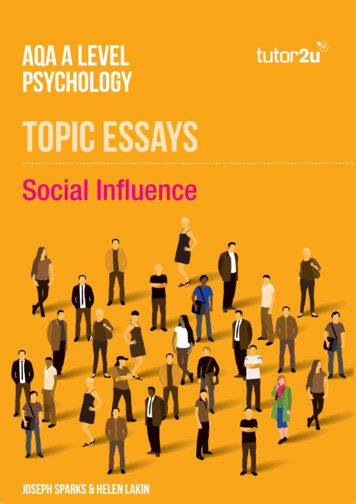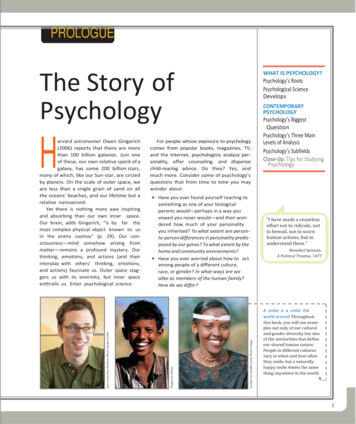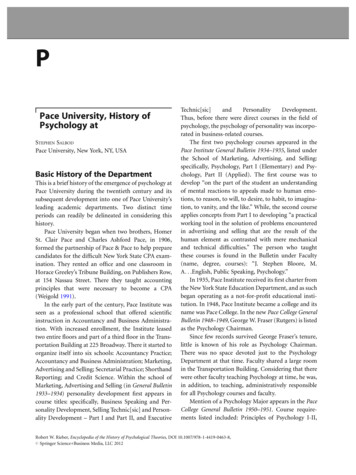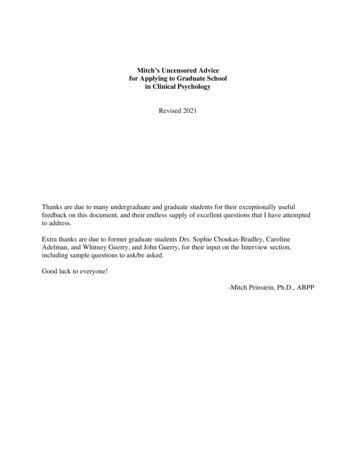
Transcription
AQA A LevelPsychologyTopic EssaysSocial InfluenceJoseph Sparks & Helen Lakin
AQA A LEVEL Psychology topic essays: Social influencePage 2Joseph and Kate are two newly qualified teachers who recently joined Christ the King College. Theircolleagues are going on a one‐day strike due to pay and conditions. When Kate was asked why she wenton strike, she said, “After sitting in the staff room and hearing the arguments from my colleagues, Irealised they were right, and the conditions are definitely getting worse for teachers”. When Joseph wasasked, he said, “I just fancied a day off and didn’t want to be the only one sitting in the office alone, so Ithought I would join everyone else”.Discuss explanations of conformity. Refer to Joseph and Kate in your answer.(16 marks)There are two key explanations of conformity: informationalsocial influence and normative social influence. Normativesocial influence (NSI) is when a person conforms to beaccepted and to feel like they belong to a group. Here a personconforms because it is socially rewarding, or to avoid socialrejection; for example, feeling like they don’t ‘fit in’.Asch’s (1956) study into conformity provides researchsupport for NSI. He found that many of the participants wentalong with the majority and provided an obviously incorrectanswer on a line judgement task. When questioned by Asch inpost‐experimental interviews, participants said that theychanged their answer to avoid disapproval from the rest ofthe group which clearly shows that NSI had occurred, as theparticipants conformed to fit in. Furthermore, Aschdemonstrated that when the pressure to publicly conform isremoved, by asking participants to write down their answerson a piece of paper rather than say them aloud, the conformityrates fell to 12.5%. This provides further evidence for NSIbecause the reduction in public pressure reduced the rate ofconformity.Key terminology defined fromthe outset with an appropriateexample to illustrate theexplanation.Effective use of two researchvariations conducted by Aschto enhance the evaluativediscussion for NSI.Joseph is demonstrating NSI because he is conforming so thathe isn’t alone and so as to join in with everyone else. Theextract doesn’t suggest that he believes the strike is right,which would be linked to informational social influence, andtherefore he is conforming to be accepted and belong to thegroup. Furthermore, Joseph is also demonstrating compliance, Appropriate reference to thewhere he is only changing his public behaviour, but not hiscontext and how NSI explainsprivate believes in the short‐term.Joseph’s behaviour.However, NSI is not the only reason that people conform andsome people conform for informational reasons.Informational Social Influence (ISI) is when a personconforms to gain knowledge, or because they believe thatsomeone else is ‘right’. ISI is usually associated withinternalisation, where a person changes both their publicbehaviour and their private beliefs, on a long‐term basis. Thiswww.tutor2u.net/psychologyWell‐detailed alternativeCopyright tutor2u Limited / School Network License / Photocopying Permitted
AQA A LEVEL Psychology topic essays: Social influencesemi‐permanent change in behaviour and belief is the resultof a person adopting a new belief system, because theygenuinely believe that their new beliefs are ‘right’ or that themajority are ‘experts’.Jenness (1932) provides research support for the role of ISI.Participants were asked to initially make independentjudgements about the number of jelly beans contained in a jarand then discuss their estimates in a group. Following thediscussion, participants then made another individual privateestimate. Jenness found that this second private estimatemoved closer to the group estimate and that females typicallyconformed more. This shows that ISI will occur in unfamiliar,ambiguous situations as the participants believe that theygain knowledge from the group and are now more likely to beright.Kate is demonstrating ISI because she is conforming becauseshe believes someone else (her colleagues) are right. Theextract states: “I realised they were right, and the conditionsare definitely getting worse for teachers”. Furthermore, Kateis also demonstrating internalisation as she has changed herpublic behaviour (by going on strike) and her private beliefs(‘I believe they are right’) which is likely to result in a long‐term semi‐permanent change in behaviour.Page 3explanation for conformity ispresented here, striking a goodbalance between NSI and ISIdescriptions.The second evaluationparagraph makes excellent useof Jenness’ research to supportthe role of ISI.Finally, the discussion is tiedback to the question to explainhow ISI explains Kate’sbehaviour, with effectivereference to the scenario.[ 525 Words]Examiner Style Comments: Mark Band 4This essay demonstrates an exceptionally clear understanding of two explanations of conformity– NSI and ISI – with explicit engagement with the scenario. The knowledge and understandingconveyed is both accurate and detailed, striking a balance between the two concepts in equaldepth. The evaluation commentary is thorough, effective and focused on the demands of thequestion. The application skills demonstrated here are established and consistent throughout theresponse.Copyright tutor2u Limited / School Network License / Photocopying Permittedwww.tutor2u.net/psychology
AQA A LEVEL Psychology topic essays: Social influencePage 4Outline and evaluate research examining conformity. (16 marks)There are two key explanations of conformity: informationalsocial influence and normative social influence. Normativesocial influence (NSI) is when a person conforms to beaccepted and to feel like they belong to a group. Here a personconforms because it is socially rewarding, or to avoid socialA strong start to the essayrejection; for example, feeling like they don’t ‘fit in’.using specialist vocabulary.Asch’s (1956) study into conformity provides researchsupport for NSI. He found that many of the participants wentalong with the majority and provided an obviously incorrectanswer on a line judgement task. When questioned by Asch inpost‐experimental interviews, participants said that theychanged their answer to avoid disapproval from the rest ofthe group which clearly shows that NSI had occurred, as theparticipants conformed to fit in. Furthermore, Aschdemonstrated that when the pressure to publicly conform isremoved, by asking participants to write down their answerson a piece of paper rather than say them aloud, the conformityrates fell to 12.5%. This provides further evidence for NSIEffective use of researchbecause the reduction in public pressure reduced the rate ofevidence to create elaboratedconformity.evaluative commentary.While the Asch study provides support for the notion of NSI,more recent research has yielded different results. Forexample, Perrin and Spencer (1980) conducted an Asch‐styleexperiment and found a conformity level of 0.25%. Therefore,it could be argued that the results of Asch are the results of adifferent era and do not represent conformity and the idea ofNSI in 2017. However, it must be noted that Perrin andSpencer used a very different sample to Asch, consisting ofengineering and mathematic students. Therefore, it could bethat the lower levels of conformity were also influenced bythe participant’s expertise in problem solving tasks.However, NSI is not the only reason that people conform andsome people conform to for informational reasons.Informational Social Influence (ISI) is when a personconforms to gain knowledge, or because they believe thatsomeone else is ‘right’. ISI is usually associated withinternalisation, where a person changes both their publicbehaviour and their private beliefs, on a long‐term basis. Thissemi‐permanent change in behaviour and belief is the resultof a person adopting a new belief system because theygenuinely believe that their new beliefs are ‘right’ or that themajority are ‘experts’.www.tutor2u.net/psychologyAn interesting counter‐argument to balance thediscussion with furtherdiscussion provided.Well‐detailed outline of asecond explanation ofconformity, again usingspecialist vocabulary in anexemplary manner.Copyright tutor2u Limited / School Network License / Photocopying Permitted
AQA A LEVEL Psychology topic essays: Social influenceJenness (1932) provides research support for the role ofinformational social influence. Participants were asked toinitially make independent judgements about the number ofjelly beans contained in a jar and then discuss their estimatesin a group. Following the discussion, participants then madeanother individual private estimate. Jenness found that thissecond private estimate moved closer to the group estimateand that females typically conformed more. This shows thatISI will occur in unfamiliar, ambiguous situations as theparticipants believe that they gain knowledge from the groupand are now more likely to be right.While Jenness provides convincing evidence for the role of ISI,it must be noted that his experiment has been criticised forlacking ecological validity. Providing an estimate of thenumber of beans in a jar is a rather mundane task with nosocial consequences. Consequently, it is legitimate to questionwhether we would display such levels of ISI in tasks that havemore significant social consequences, for example, hearingevidence in a court case from an ‘expert’ barrister. Therefore,until further research examining ISI is conducted in the real‐world, these results remain confined to the laboratory.Page 5Research support for the roleof ISI is well‐detailed andaccurate.Limitation of Jenness studycreates a balance in thediscussion for the role of ISI inconformity.[ 575 Words]Examiner Style Comments: Mark Band 4This is a well‐structured essay which evidently followed a clear plan to outline and evaluate NSIand then repeat this formula for ISI. This has proved effective to create a response whicheffectively deals with several pieces of research examining conformity as a form of socialinfluence. The use of specialist terminology is consistent throughout.Copyright tutor2u Limited / School Network License / Photocopying Permittedwww.tutor2u.net/psychology
AQA A LEVEL Psychology topic essays: Social influencePage 6Discuss factors that can affect conformity. Refer to variations of Asch’sexperiment in your answer. (16 marks)There are three main factors that affect whether a personconforms: group size, unanimity and task difficulty. Firstly, itis logical to assume that a larger group will increase the rateof conformity, because the size of the social pressureincreases.However, research by Asch has found that the effect of groupsize is not so straight forward. In Asch’s original experiment,one real participant was placed among six to eightconfederates. Asch found that the average conformity ratewas 32%. Asch found that when there was only oneconfederate, conformity dropped to just 3% and when therewere two, conformity dropped to 12.8%. However, with threeconfederates, Asch found that conformity remained the sameat around 32%. Increasing the group size has limitations.When Asch increased the size of the majority to 15confederates he found that conformity started to drop. Thismay be because the situation is seen as bizarre and theparticipants started to become suspicious, leading to demandcharacteristics. These results show that group size has asignificant impact on conformity and that when a group hasthree or more people, conformity reaches its highest level atapproximately 32%.Another factor that affects conformity is unanimity, which isthe extent to which the majority agree in their views orbehaviour. If a majority if unanimous in their opinion, thenthey are more likely to have a significant impact.Asch examined the idea of unanimity in a variation where oneof the confederates was instructed to give the correct answerthroughout. In this variation, the average conformity ratedropped to just 5%. This shows that when a majority isbroken, people are more likely to resist the pressure toconform. This is because they do not feel as though they arealone and they do not have to go along with the group.The final factor that affects conformity is task difficulty. In theoriginal Asch experiment the correct answer was alwaysobvious; therefore, the participants were conforming due tonormative social influence and a desire to fit in.However, in one of the variations, Asch made the length oflines significantly smaller and more difficult to judge. In thisvariation, Asch found that the rate of conformity increased.www.tutor2u.net/psychologyA swift introduction, namingthe key factors that can affectconformity. Group size as afactor is clearly explained.Well‐detailed and highlyaccurate knowledge of groupsize and Asch’s variations ispresented.This discussion is linked to thequestion and considers thepossible impact of demandcharacteristics.The idea of unanimity is well‐explained and accurate.Appropriate reference toAsch’s variation whichdemonstrates support for thenotion of unanimity affectingconformity rates.The third, and final, factor oftask difficult is well explained.Copyright tutor2u Limited / School Network License / Photocopying Permitted
AQA A LEVEL Psychology topic essays: Social influenceThis is likely to be the result of informational social influence,as individuals look to another for guidance when completingthe task, suggesting that as tasks become more difficult,people are more likely to conform. Furthermore, Jenness(1932) also provides research support for the idea of taskdifficultly. In Jenness’ study, participants were asked toinitially make independent judgements about the number ofjelly beans contained in a jar and then discuss their estimatesin a group. Following the discussion, participants then madeanother individual private estimate. Jenness found that thissecond private estimate moved closer towards the groupestimate. Jenness concluded that this shift in judgement wasdue to the ambiguity of the task and therefore the difficult ofthe task led people to conform for informational reasons, asthey believed that the group were more likely to be correct.Page 7The evaluative commentary isclear and draws on twosupporting studies that arelinked to informational socialinfluence.[ 525 Words]Examiner Style Comments: Mark Band 4This is a well‐detailed answer which accurately outlines the three factors which are named onthe specification that can affect conformity, namely: group size, unanimity and task difficulty.Each section outlines the factor, draws on supporting research by Asch and provides a thoroughand effective discussion linked back to the question. Furthermore, the answer integratesspecialist terminology throughout, including references to normative and informational socialinfluence.Copyright tutor2u Limited / School Network License / Photocopying Permittedwww.tutor2u.net/psychology
AQA A LEVEL Psychology topic essays: Social influencePage 8Outline and evaluate research into conformity to social roles. (16 marks)Zimbardo (1973) conducted a study on conformity to socialroles, called the Stanford Prison Experiment. The aim of hisexperiment was to examine whether people would conform togiven social roles when placed in a mock prison environment.His sample consisted of male university students who wererandomly assigned to one of two social roles: prisoner orguard. The ‘prisoners’ were arrested by local police, given anumbered smocked to wear, and chains were placed aroundtheir ankles. The guards were given uniforms, sunglasses,handcuffs and a truncheon and were instructed to run theprison without using physical violence. The experiment wasset to run for two weeks, although it was terminated afteronly six days.Zimbardo found that both the prisoners and guards quicklyidentified with their social roles. Within days the prisonersrebelled, which was quickly crushed by the guards, who thengrew increasingly abusive towards them. The guardsdehumanised the prisoners, waking them during the nightand forcing them to clean toilets with their bare hands; theprisoners became increasingly submissive, identifying furtherwith their subordinate role.A recent replication of the Stanford Prison Experiment,carried out by Reicher and Haslam (2006), contradicts thefindings of Zimbardo. In this replication, the participants didnot conform to their social roles automatically. For example,the guards did not identify with their status and refused toimpose their authority; the prisoners identified as a group tochallenge the guard’s authority, which resulted in a shift ofpower and a collapse of the prison system. These resultsclearly contradict the findings of Zimbardo and suggest thatconformity to social roles may not be automatic, as Zimbardooriginally implied.A timely introduction namingappropriate research intoconformity to social roles fromthe offset.Accurate and detaileddescription of Zimbardo’sprocedure in assigning socialroles to the participants.Clear knowledge of the keyfindings from the StanfordPrison Experiment arepresented.An effective evaluation pointdrawing attention tocontradictory research on thesame topic.Furthermore, individual differences and personality alsodetermine the extent to which a person conforms to socialroles. In Zimbardo’s original experiment, the behaviour of theguards varied dramatically, from extremely sadistic behaviourdisplayed by around one third of the participants in that role,to a few guards who actually helped the prisoners by offeringsupport and sympathy, giving cigarettes and reinstating lostprivileges. This suggests that situational factors are not theonly cause of conformity to social roles, and dispositionalfactors such as personality also play a role, implying thatAn interesting factor toZimbardo’s conclusion could have been opyright tutor2u Limited / School Network License / Photocopying Permitted
AQA A LEVEL Psychology topic essays: Social influenceZimbardo’s experiment has been heavily criticised forbreaking many ethical guidelines, especially protection fromharm. Five of the prisoners left the experiment early becauseof their adverse reactions to the physical and mental torment.Furthermore, some of the guards reported feelings of anxietyand guilt as a result of their actions during the Stanford PrisonExperiment. Although Zimbardo followed the ethicalguidelines of Stanford University and debriefed hisparticipants afterwards, he acknowledged that the studyshould have been stopped earlier. It has been suggested thathe was responding more in the role of superintendent of theprison rather than as the researcher with responsibility forhis participants. Furthermore, the fact that Zimbardo onlyused male participants in his sample shows a beta bias, as hisresearch may have ignored or minimised the differencesbetween men and women in relation to conformity to socialroles and therefore we are unable to conclude whetherfemales conform to social roles in a similar way.Page 9Effective evaluativecommentary includingreference to ethical issues andthe additional issue of betabias.[ 525 Words]Examiner Style Comments: Mark Band 4This is a well‐detailed and accurate account of Zimbardo’s Stanford Prison Experimentinvestigating conformity to social roles. The outline is concise, yet thorough. The evaluationcommentary is effective in most places with the final paragraph highlighting the controversialnature of the study, culminating the high‐level discussion of Zimbardo’s work.Copyright tutor2u Limited / School Network License / Photocopying Permittedwww.tutor2u.net/psychology
Page 10AQA A LEVEL Psychology topic essays: Social influenceDiscuss research into obedience as investigated by Milgram. (16 marks)Milgram investigated whether ordinary people would obey anorder to inflict pain on an innocent person. His sample of 40male American volunteers went to Yale University, wherethey met the experimenter and another participant (aconfederate). It was fixed so that the real participant wasassigned the role of ‘teacher’ and instructed to give an electricshock of increasing strength (from 15–450 volts) to the‘learner’ every time he made a mistake on a list of word pairs.At 300 volts the learner could be heard complaining, but afterthat there were no further responses. The experimentcontinued until either the participant refused to continue, orthe maximum of 450 volts was reached. If they tried to stop,the experimenter would offer a verbal prod, e.g. ‘Theexperiment requires that you continue’. Milgram found thatall participants went to 300 volts and 65% administered thefull 450 volts. In addition, qualitative observations reportparticipants showing signs of distress and tension: sweating,stuttering and trembling.One criticism of Milgram’s study is that it broke severalethical guidelines. Milgram deceived his participants as theybelieved that they were taking part in a study on howpunishment affects learning, rather than on obedience. Theywere also deceived by the rigging of the role allocation thatwas in fact pre‐determined. Due to the nature of the task,Milgram did not protect the participants from psychologicalharm, since many of them showed signs of real distress duringthe experiment and may have continued to feel guiltyfollowing the experiment, knowing that they could haveharmed another human being. Some critics of Milgrambelieved that these breaches could serve to damage thereputation of psychology and jeopardise future research.Another criticism of Milgram’s study is that it lacks ecologicalvalidity. This is because Milgram conducted a laboratorystudy, which is very different from real‐life situations ofobedience. In everyday life, we often obey far more harmlessinstructions, rather than giving people electric shocks. As aresult, we are unable to generalise his findings to real lifesituations of obedience and cannot conclude that peoplewould obey less severe instructions to the same degree.However, Milgram counters this claim, stating that thelaboratory can reflect wider authority relationships seen inreal‐life situations. For example, Hofling et al. (1966) foundthat nurses were surprisingly obedient to unjustifiedinstructions from a doctor in a hospital setting and thiswww.tutor2u.net/psychologyMilgram’s aim is clearly statedat the offset.An accurate overview ofMilgram’s procedure ispresented.Thorough knowledge ofMilgram’s findings is evident.An interesting start to theevaluative commentaryconsidering the lasting impactof this infamous study.Another well‐measuredlimitation of Milgram’sresearch on obedience isconsidered in the secondevaluation paragraph.However, the answer alsoprovides an effective counter‐Copyright tutor2u Limited / School Network License / Photocopying Permitted
AQA A LEVEL Psychology topic essays: Social influencesuggests that Milgram’s findings do apply outside thelaboratory.Another methodological criticism of Milgram’s study is that itlacks population validity. This is because Milgram used abiased sample of 40 male American volunteers from a broadlyindividualistic society. Therefore, we are unable to generalisethe results to other populations, particularly collectivistcultures, or to explain the behaviour of females since it cannotbe concluded that those with other cultural experiences, orfemale participants, would respond in a similar way to thatobserved originally by Milgram. The fact that Milgram onlyused male participants in his original sample shows a betabias, as his research may have ignored or minimised thedifferences between men and women in relation to theconclusions drawn regarding obedience to authority. It canalso be criticised as being androcentric, since the resultscannot be generalised to females.Page 11criticism to develop this pointfurther.The final discussion commentconsiders the issues of culturalbias and beta biasappropriately, relating backthe evaluation back to thequestion.[ 550 Words]Examiner Style Comments: Mark Band 4This is an excellent response to this exam question. The answer shows sound knowledge andunderstanding of Milgram’s original study investigating obedience to authority. The discussion iscantered on three limitations and provides an in‐depth commentary that is thorough andeffective, embedding issues and debates, with consistent use of specialist terminology.Copyright tutor2u Limited / School Network License / Photocopying Permittedwww.tutor2u.net/psychology
Page 12AQA A LEVEL Psychology topic essays: Social influenceOutline and evaluate how situational variables have been shown to affectobedience to authority. (16 marks)Situational variables focus on external factors that affect theThe three situational variableslikelihood that someone will obey orders, including proximity, affecting obedience named onlocation and uniform.the specification are namedfrom the outset.Milgram conducted his original research in a laboratory ofYale University. In order to test the power of the location,Milgram conducted a variation in a rundown building inBridgeport, Connecticut. In this variation, the percentage ofparticipants who administered the full 450 volts droppedfrom 65% to 47.5%, highlighting the importance of location in Well‐explained impact ofcreating a prestigious atmosphere generating respect andlocation with accurateobedience.findings presented.Likewise, Milgram demonstrated the power of uniform in avariation where the experimenter was called away andreplaced by another ‘participant’ (confederate) in normalclothes, rather than a lab coat. Here, the percentage ofparticipants who administered the full shock dropped to 20%.While this variation appears to suggest that uniform is animportant factor that affects obedience to authority, it isunclear from this variation alone whether the uniform is theWell‐detailed knowledge ofcontributing factor or whether the experimenter also appears Milgram’s variations is used tomore legitimate due to his social status and role.support the notion of uniform.However, there is additional research support for the role ofuniform affecting obedience rates. Bickman (1974) conducteda field experiment in New York City where confederates stoodon the street and asked members of the public who werepassing by to perform a small task such as picking up a pieceof litter or providing a coin for the parking meter. The outfitthat the confederate was wearing varied from a smart suit,jacket and tie, a milkman’s outfit or a security guard’suniform. It was found that in this final condition the membersof the public were twice as likely to obey the order given bythe ‘security guard’, which supports Milgram’s idea that auniform adds to the legitimacy of the authority figure and is asituational variable which increases obedience levels.Proximity refers to how close someone or something is. In avariation of Milgram’s experiment where the teacher andlearner were in the same room, the percentage of participantswho administered the full 450 volts dropped from 65% to40% because the teacher could understand the learner’s painmore directly. In another variation, the experimenter left theroom and gave the instructions over the telephone. With thiswww.tutor2u.net/psychologyEffective evaluation drawingon relevant research supportfrom Bickman to illustrate thepower of the uniform inaffecting obedience.Copyright tutor2u Limited / School Network License / Photocopying Permitted
AQA A LEVEL Psychology topic essays: Social influencevariation the obedience levels fell even further to 20.5%. Thisshows that proximity affects obedience in two ways: 1) thecloser a person is to an authority figure the more likely theyare to obey; 2) the closer a person is to the consequences oftheir actions, the less likely they are to obey.While situational variables like uniform and proximity areseen to be important, research suggests that other factors (e.g.culture) also play an important role. Kilman and Mann (1974)replicated Milgram’s original study procedures in Australiabut found that only 16% of the participants shocked thelearner at the maximum voltage level of 450V whereasMantell (1971), on the other hand, showed that it was 85%when conducted in Germany. This cross‐cultural comparisonshows that different societies follow alternative hierarchicalstructures and children may be socialised differently from ayoung age to be more, or less, obedient. This suggests thatwhile situational factors like uniform and proximity areimportant, other factors may play a more significant role inobedient behaviour.Page 13The notion of proximity isdefined and thendemonstrated with twoappropriate variations fromMilgram.A well‐detailed and effectiveevaluation point drawing oncross‐cultural research is usedto explore other contributingfactors.[ 525 Words]Examiner Style Comments: Mark Band 4This response is of an appropriate length for a question which attempts to cover all threesituational variables affecting obedience named on the specification. The elusive breadth anddepth trade‐off has been achieved through precise and accurate description and interesting andwell‐elaborated discussion. The enmeshment of issues and debates into the responsedemonstrates a high level of knowledge and understanding of the demands for those wanting tosecure entry into the top mark band.Copyright tutor2u Limited / School Network License / Photocopying Permittedwww.tutor2u.net/psychology
Page 14AQA A LEVEL Psychology topic essays: Social influenceOutline and evaluate the authoritarian personality as a dispositionalexplanation for obedience. (16 marks)Dispositional explanations for obedience focus on internal(personality) characteristics within humans that contribute toobedience. One particular explanation focuses on theauthoritarian personality which was proposed by Adorno.Adorno et al. (1950) believed that the foundations for ana
evidence in a court case from an ‘expert’ barrister. Therefore, until further research examining ISI is conducted in the real‐ world, these results remain confined to the laboratory. [ 575 Words] Research support for the role of ISI is well‐detailed and accur










